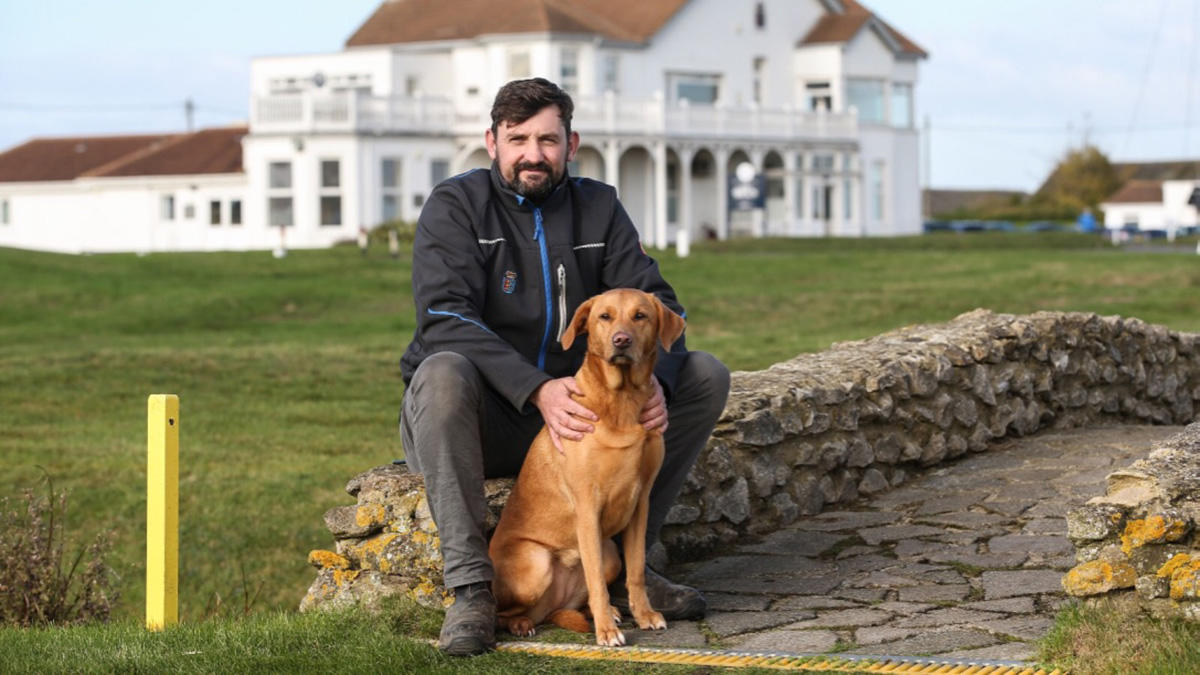- Homepage
- News and Features
- How golfers and greenkeepers can learn to communicate
How golfers and greenkeepers can learn to communicate

James and his dog, Stevie, at Royal Cinque Ports
Over recent years, the do’s and don’ts of social media in the turf industry have been discussed at length.
On the whole I’m sure the majority of us agree that social media helps us to communicate and share ideas with other like‑minded greenkeepers. However, there is an area of communication that is just as important – communication to the members of our golf clubs and visitors!
Many golf club members see their course as more than a place to play golf and socialise. They are proud of their piece of land. Many are avid gardeners and have a nice lawn at home and because of this they take interest in the turf or any project work that may be taking place at the golf course during the season or in winter. Other members live far away and only visit every so often, so the chance to see what’s been happening on the golf course gives them a sense of enjoyment of ownership.
Is it our duty to keep them informed? Or is this the job of the general manager or secretary?
Have we got time to do this? And where do we even start?
This feature will cover some of the various forms of communication that may improve the relationships between greenkeepers and members.
What do we want to achieve?
Picture the scene: it’s a cold Sunday afternoon in February in the bar at the club. Mr Smith is having post round drinks with Mr Jones and is perplexed at his putting display after adding yet another 0.1 to his handicap.
“The greens were bumpy today, I have no idea why they get the greens half decent then dig them up, I heard they did it because they have a disease that is spiralling out of control!” he proclaims.
Mr Smith is referring to a 13mm solid tine that the greens received the previous Monday as part of a preventative cultural programme that enhances turf health and discourages disease. The discontentment is spread around any poor suspects who join Mr Smith’s table.
This spreads like wildfire around the bar and within the hour the course manager is public enemy number one, until Mr Brown steps in. Mr Brown is computer savvy and has subscribed to the greenkeeper’s blog and receives notifications. On Monday night he sat beside the fire with his tablet and watched an incredibly interesting video made by the course manager that showed the operation and detailed the reasons for doing so. The negativity see‑saw soon started to change as Mr Brown was compelled to support the course manager and the reasons for carrying out such maintenance.
Club blog
We want to spread facts and stop Chinese whispers and I have found that a course manager’s blog is a good example of doing so.
Helpful tips to keeping a successful blog:
Make sure grammar and spelling is correct. Readers will notice and lose interest and respect if this is poor.
Try and post fairly regularly. This doesn’t mean you should post every time you set up the course for a ladies medal, but keep it for interesting jobs and projects and try not to repeat yourself too much.
A picture paints a thousand words so make sure your pictures are top quality and do the course justice.
Refrain from posting anything negative, much like the number one social media rule. Remember, the entire internet can see your post and it is a representation of yourself, your team and your club. If you are posting pictures of disease, that’s fine, but remember to post the ‘after’ photos, along with an in depth explanation of how you cured it. With less fungicides available, educating members has never been more important.
Welcome questions and comments from members and evoke discussion that will further help eliminate whispers.
If you’re confident in doing so, include well‑edited videos (vlogs) that are far more interesting than words and pictures. They are a lot more personable and let the members get to know their greenstaff better as they can put a name to a face (and even a voice) for those brave enough to step in front of the camera.

A course walk is an excellent way of communicating with the golfers at your club
Course walks
As previously stated, many golfers love their gardens, so what better way to communicate than to do so out on the course? Again, much like the spread of positivity through the bar thanks to good old Mr Brown and the same can happen when members see what the course manager is trying to achieve first hand.
Helpful tips on hosting a successful course walk:
Plan a route and areas (stations) you wish to show members. Make sure you have all the facts. If you are showing them a newly constructed green for example, make sure you know how many tons of each material was used, the grasses used, how much everything cost and the process the staff went through. Don’t be caught out, you are the expert and you don’t ever want them to think otherwise by being unprepared.
Elevate yourself. When addressing a crowd, make sure everyone can see you and you have a good physical presence. Make yourself heard, speak loudly and clearly address each individual.
Give out handouts if required. For example, if you have new facilities you may want to show architects’ drawings or photos of the old facilities. This is often a good addition and it may also be good bedtime reading for those who take an exceptional interest.
Make sure everyone sticks together. Brief everyone at the start of the walk and wait until they all arrive at the next place of interest before starting to talk. Don’t be afraid to hurry people along, even if it is the captain!
Tours of the maintenance facilities are a fantastic idea, no matter if you have an all singing, all dancing facility or an old rickety shed. It is great to let the members see what you work out of and where » their money goes. 90% of members have no clue whatsoever about the technology that goes in to keeping our courses pristine and the expense that comes with the modern technology that helps keep up with the Jones’s. Irrigation software is particularly interesting and with irrigation systems on some courses being the most expensive asset, it is good to show this to the membership. It is often overlooked, with the majority of the system being hidden underground.

Weather conditions play a role in what greenkeepers can achieve and it's important that golfers understand this
Clubhouse presentations
For many members, the safety and comfort of the bar can be a more favourable option for an alternative to a course walk. Members evenings are common events at golf courses across the country. More often than not they are instigated by the committee or board. However, there is no reason why the course manager or head greenkeeper can’t get the ball rolling.
Helpful tips on hosting a successful members’ evening:
Plan the evening around a busy time at the club, such as a large members’ tournament or a public holiday when members from further afield may be visiting.
Entice members along by offering food. A few trays of lasagne are fairly inexpensive to put together and food is always the way to a member’s heart! This also helps to relax everyone and makes for a nicer atmosphere. You could even go as far as to have a quiz afterwards and make a proper evening of it. Hang about and answer questions, build a relationship with the membership and hopefully they are respectful enough to ask fair questions.
Prepare a Powerpoint presentation. A well put‑together presentation can be extremely engaging and even though it can be nerve wracking it will help your personal progression and enable you to use presentation skills elsewhere. Addressing your staff should become easier after mastering this skill. Make sure the screen is large and clear enough, especially for elderly members and if you use audio visual tools, always make sure it is working and can be heard.
Provide facts and figures. Many of your committee or board may work in business or finance and may relate to graphs, pie charts or spreadsheets. Show off your skills as a modern turf manager and show them how complex and interesting turf management can be!
Try to be prepared for awkward questions, but remember no one knows everything and it’s quite acceptable to say you are not sure of the answer and will reply at a later date. The answer to this could easily be part of a review of the evening in the form of a blog entry.
It’s sometimes not always smiles and handshakes, pleasantries and compliments. There will be members who will always be completely unreasonable (in your mind), no matter how well you carry out all of the above.
The important thing to remember is that in communicating with members, you are doing the right thing.
By doing so I guarantee your relationship with your members will be enriched. You will be seen as a more competent turf manager who knows their course and their trade and most importantly it will show everyone how much you love your job, your industry and your club. Your members are your most important customers.
Must hurry along, I have a tee time with Mr Smith, Mr Jones and Mr Brown!
James was writing for Greenkeeper International, the monthly magazine of the British and International Golf Greenkeepers Association, which seeks to support the needs of golf greenkeepers and other groundsmen, both in the United Kingdom and overseas.
Author


